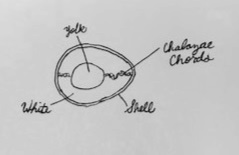Anatomy of an Egg
I got my degree in Baking and Pastry at culinary school. And one thing most people do not realize about baking is the few base ingredients needed. These are staples in most kitchens and can be used with different techniques to create different final products. The chicken’s egg is one of these base ingredients, and it’s versatility has a special place in my heart. Eggs can be used in recipes to add flavor, as a thickener, to tenderize and enrich doughs, and can extend the shelf life of certain recipes. They also can be used as an emulsifier for sauces (think mayonnaise or hollandaise), soften bread crusts in egg washes, clarify stocks and prevents crystallization in candies and merengue frostings. As a professional cook, I feel it is important to know the anatomy of your ingredients. A chicken’s egg can be divided into four parts aside from the membranes; the shell, yolk, white and chalazae chords.
Chalazae Chords: There are two of these chords in each egg and are used to keep the delicate yolk suspended in the white. This way the yolk will not break inside the egg if jostled and make the separating process for eggs easier. If separating eggs for a merengue, do not worry if the chords are in the egg white, it will not deflate them.
Shell: This part of the egg is porous and keeps the moisture inside the egg. It is made of calcium carbonate and can be used to enrich the soil in your garden, or to start seeds. One misconception about the shell is that the color matters, brown shells are not more organic or have less unnatural chemicals than white shell eggs. Shell color is determined by genetics.
White: A more scientific name being the Albumen, this part of the egg contains most of the protein. The white also has a thicker consistency around the yolk and coagulates at 144F-149˚F (Or 62˚C-65˚C for those of you not in the US). Most uses of egg whites alone are merengue based like pavlovas, cookies, icings, and sponges.
Yolk: The small yellow center of the egg is about half of the size of the white but contains all the fat. This part of the egg solidifies at 149˚F-158˚F (65˚C-70˚C). Yolks can be used in icings like French Buttercream, pastry cream, breads, sponge cake and anglaise. Yolks can also be cured in salt and grated over salads or pasta dishes.
